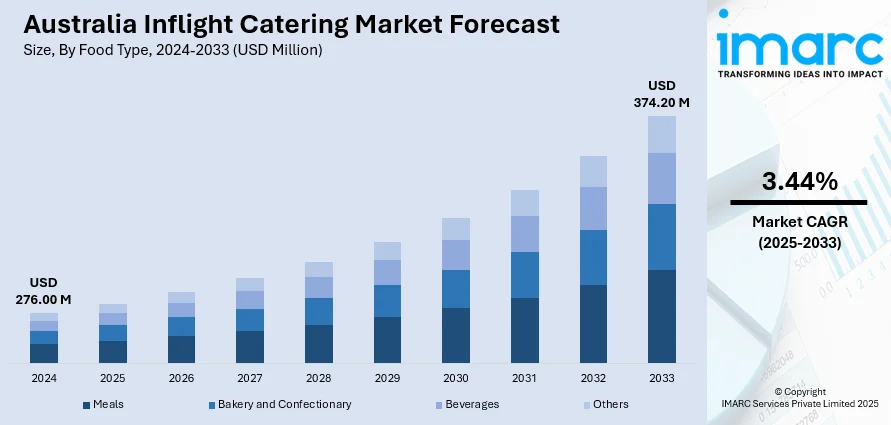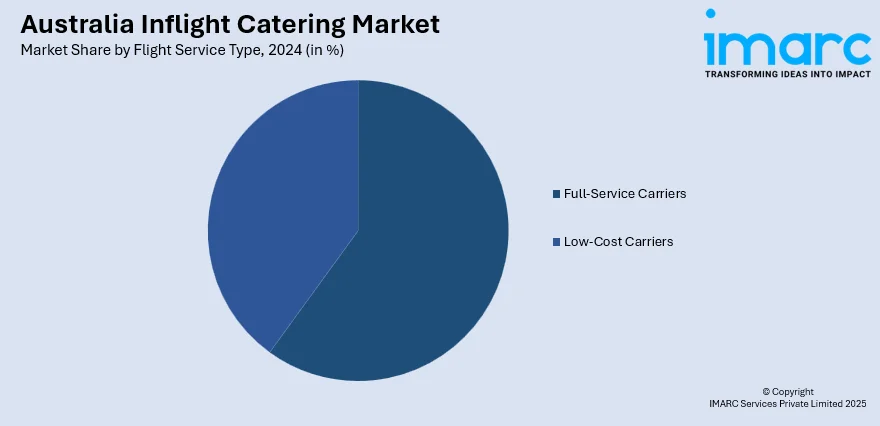
Australia Inflight Catering Market Size, Share, Trends and Forecast by Food Type, Flight Service Type, Aircraft Seating Class, and Region, 2025-2033
Australia Inflight Catering Market Overview:
The Australia inflight catering market size reached USD 276.00 Million in 2024. Looking forward, IMARC Group expects the market to reach USD 374.20 Million by 2033, exhibiting a growth rate (CAGR) of 3.44% during 2025-2033. Rising air passenger traffic, elevating demand for personalized and health-conscious meals, airline investments in premium onboard services, sustainability-driven food sourcing, and technological innovations in menu planning and logistics are collectively driving the Australia inflight catering market by enhancing service quality, operational efficiency, and passenger satisfaction.
|
Report Attribute
|
Key Statistics
|
|---|---|
|
Base Year
|
2024
|
|
Forecast Years
|
2025-2033
|
|
Historical Years
|
2019-2024
|
| Market Size in 2024 | USD 276.00 Million |
| Market Forecast in 2033 | USD 374.20 Million |
| Market Growth Rate (2025-2033) | 3.44% |
Australia Inflight Catering Market Trends:
Surge in International and Domestic Air Passenger Traffic
Among the key factors driving the Australian inflight catering market are the rising levels of domestic and international air passenger traffic. The Australian aviation sector is witnessing a boom fueled by pent-up post-pandemic travel demand, increased airline routes, and easing visa norms. Global tourism has recovered comprehensively, with an increasing number of tourists arriving from Asia, Europe, and North America, particularly fueled by the popularity of Australia as a high-end travel destination with rich natural and cultural experiences. Additionally, Australia's vast geography requires air transport between major cities like Sydney, Melbourne, Brisbane, and Perth. This geographical imperative automatically creates demand for domestic airline services, which, in turn, puts greater emphasis on onboard amenities, among them in-flight meals. Moreover, both low-cost carriers and full-service airlines are now spending more on inflight services to differentiate themselves from competitors. This not only covers the quantity and quality of meals but also personalized ordering based on dietary choices.

To get more information on this market, Request Sample
Evolving Consumer Preferences Towards Health, Sustainability, and Personalization
Another factor driving the inflight catering industry in Australia is the cultural shift towards more healthy, sustainable, and bespoke meal choices. Contemporary air travelers—particularly millennials and Gen Z—are much more aware of the food they put into their bodies, even inflight. Consumers are moving away from typical, mass-produced fare towards organic, plant-based, allergen-free, and gourmet-style fare consistent with personal nutritional requirements. This evolving trend is compelling inflight catering companies to change their menu development processes, providing the source of all ingredients as locally grown or organic and the packaging as eco-friendly. Airlines are labeling their onboard menus as "farm-to-tray" or "chef-inspired" and carrying the ingredient source to appeal to modern travelers. Many airlines in Australia are also proactively and actively working together with nutritionists and celebrity chefs to design meals that are not only delicious but also nutritious. Alongside health, sustainability is a focal issue. There are demands on airlines and caterers to manage food waste and carbon emissions. This has spurred the implementation of AI-enabled demand forecasting, biodegradable trays, and recycling initiatives. Thus, the impact of consumer values is transforming all aspects of inflight catering, ranging from food purchasing to meal presentation, making this a crucial and dynamic driver.
Australia Inflight Catering Market Segmentation:
IMARC Group provides an analysis of the key trends in each segment of the market, along with forecasts at the region/country level for 2025-2033. Our report has categorized the market based on food type, flight service type, and aircraft seating glass.
Food Type Insights:
- Meals
- Bakery and Confectionary
- Beverages
- Others
The report has provided a detailed breakup and analysis of the market based on the food type. This includes meals, bakery and confectionary, beverages, and others.
Flight Service Type Insights:

- Full-Service Carriers
- Low-Cost Carriers
A detailed breakup and analysis of the market based on the flight service type have also been provided in the report. This includes full-service carriers and low-cost carriers.
Aircraft Seating Class Insights:
- Economy Class
- Business Class
- First Class
The report has provided a detailed breakup and analysis of the market based on the aircraft seating class. This includes economy class, business class, and first class.
Regional Insights:
- Australia Capital Territory & New South Wales
- Victoria & Tasmania
- Queensland
- Northern Territory & Southern Australia
- Western Australia
The report has also provided a comprehensive analysis of all the major regional markets, which include Australia Capital Territory & New South Wales, Victoria & Tasmania, Queensland, Northern Territory & Southern Australia, and Western Australia.
Competitive Landscape:
The market research report has also provided a comprehensive analysis of the competitive landscape. Competitive analysis such as market structure, key player positioning, top winning strategies, competitive dashboard, and company evaluation quadrant has been covered in the report. Also, detailed profiles of all major companies have been provided.
Australia Inflight Catering Market News:
- January 2025: Dubai National Air Travel Agency (commonly known as “dnata”) Catering & Retail invested AUD 50 million to expand its Melbourne Airport facility by 5,700m², increasing its capacity to produce 25 million meals annually. This expansion, which reportedly makes dnata the largest airline catering center in Victoria, supports escalating demand and enhances service capabilities for over 60,000 flights each year.
- June 2024: Virgin Australia introduced a revamped inflight menu, marking its most significant culinary update in five years. The new Business Class offerings feature globally inspired dishes, including corn fritters with goat cheese, soba noodle salad with teriyaki chicken, and mango coconut cake, all crafted from locally sourced Australian produce. Economy passengers can also purchase items like ham and cheese sourdough toasties, chicken pesto wraps, and hot meals such as Penang chicken curry on select routes.
Australia Inflight Catering Market Report Coverage:
| Report Features | Details |
|---|---|
| Base Year of the Analysis | 2024 |
| Historical Period | 2019-2024 |
| Forecast Period | 2025-2033 |
| Units | Million USD |
| Scope of the Report |
Exploration of Historical Trends and Market Outlook, Industry Catalysts and Challenges, Segment-Wise Historical and Future Market Assessment:
|
| Food Types Covered | Meals, Bakery and Confectionary, Beverages, Others |
| Flight Service Types Covered | Full-Service Carriers, Low-Cost Carriers |
| Aircraft Seating Classes Covered | Economy Class, Business Class, First Class |
| Regions Covered | Australia Capital Territory & New South Wales, Victoria & Tasmania, Queensland, Northern Territory & Southern Australia, Western Australia |
| Customization Scope | 10% Free Customization |
| Post-Sale Analyst Support | 10-12 Weeks |
| Delivery Format | PDF and Excel through Email (We can also provide the editable version of the report in PPT/Word format on special request) |
Key Questions Answered in This Report:
- How has the Australia inflight catering market performed so far and how will it perform in the coming years?
- What is the breakup of the Australia inflight catering market on the basis of food type?
- What is the breakup of the Australia inflight catering market on the basis of flight service type?
- What is the breakup of the Australia inflight catering market on the basis of aircraft seating class?
- What are the various stages in the value chain of the Australia inflight catering market?
- What are the key driving factors and challenges in the Australia inflight catering market?
- What is the structure of the Australia inflight catering market and who are the key players?
- What is the degree of competition in the Australia inflight catering market?
Key Benefits for Stakeholders:
- IMARC’s industry report offers a comprehensive quantitative analysis of various market segments, historical and current market trends, market forecasts, and dynamics of the Australia inflight catering market from 2019-2033.
- The research report provides the latest information on the market drivers, challenges, and opportunities in the Australia inflight catering market.
- Porter's five forces analysis assist stakeholders in assessing the impact of new entrants, competitive rivalry, supplier power, buyer power, and the threat of substitution. It helps stakeholders to analyze the level of competition within the Australia inflight catering industry and its attractiveness.
- Competitive landscape allows stakeholders to understand their competitive environment and provides an insight into the current positions of key players in the market.
Need more help?
- Speak to our experienced analysts for insights on the current market scenarios.
- Include additional segments and countries to customize the report as per your requirement.
- Gain an unparalleled competitive advantage in your domain by understanding how to utilize the report and positively impacting your operations and revenue.
- For further assistance, please connect with our analysts.
 Request Customization
Request Customization
 Speak to an Analyst
Speak to an Analyst
 Request Brochure
Request Brochure
 Inquire Before Buying
Inquire Before Buying




.webp)




.webp)












